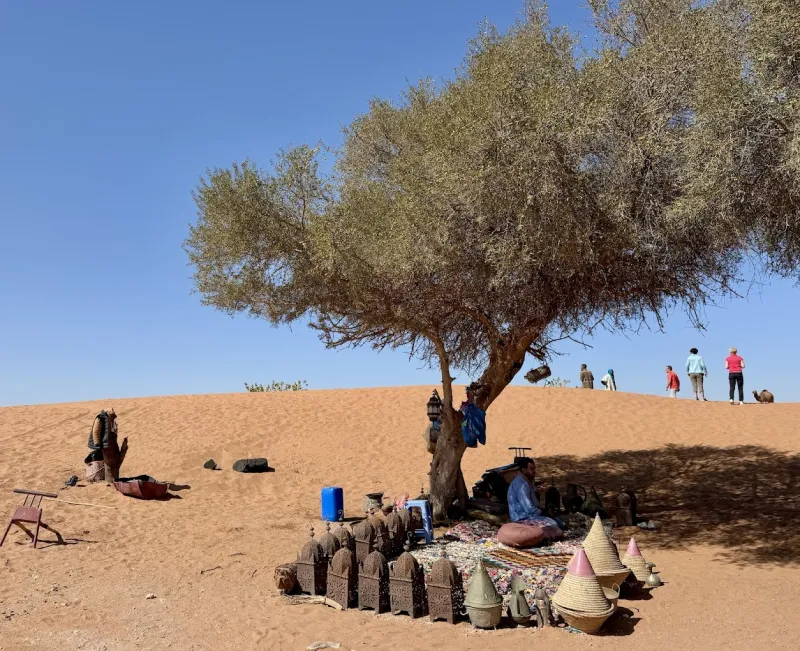Local Cuisine Markets: A Foodie’s Guide
15 Mar 2025Marrakech is a melting pot of aromas, flavors, and culinary traditions that burst forth in every corner of its bustling food markets. These lively bazaars are not only a feast for the senses—they are living archives of local culture where recipes have been handed down through generations and every vendor has a story to tell. In this guide, we’ll take you on a journey through Marrakech’s most vibrant food markets, share authentic recipes that capture the spirit of Moroccan cuisine, and offer exclusive insights from vendors who reveal the secrets behind their signature dishes.
The Heartbeat of Marrakech: Exploring Local Food Markets
A Feast for the Senses
Marrakech’s food markets, or souks, are a dynamic stage for Morocco’s rich culinary traditions. Stepping into these markets, you’re immediately enveloped by the heady mix of spices, freshly squeezed juices, sizzling street food, and sweet treats. The vibrant displays of colorful fruits, vegetables, and aromatic herbs invite visitors to embark on a culinary adventure that is both educational and deeply satisfying.
Sensory Overload: From the fragrant cumin and saffron to the tangy aroma of preserved lemons and the earthy scent of olives, every stall in the market is a symphony of flavors and aromas.
Cultural Tapestry: The markets are not only places to purchase ingredients but also communal hubs where locals share recipes, exchange cooking tips, and celebrate the art of Moroccan cuisine. They are living museums where traditional techniques meet modern innovations.
Must-Visit Food Markets
1. Souk Semmarine
Souk Semmarine is a vibrant market where you can find everything from fresh produce and spices to handcrafted utensils that are essential for preparing traditional Moroccan dishes. This market is perfect for both experienced cooks and curious food lovers eager to learn about local ingredients.
What to Find: Fresh herbs, dried fruits, olives, and a dazzling array of spices like ras el hanout—a secret blend of over 30 spices that adds depth and warmth to any dish.
Local Tip: Engage with vendors about the best seasonal produce. They often share tips on how to select the ripest tomatoes or the freshest herbs, which can be the key to perfecting your recipe.
2. Marché de Bab Doukkala
Located in one of Marrakech’s largest open-air markets, Bab Doukkala offers a sensory journey into the heart of Moroccan culinary traditions. Here, you’ll find not only fresh ingredients but also ready-to-eat delights that have been perfected over generations.
Highlights: Try the freshly baked khobz (Moroccan bread), sample local cheeses, and enjoy stalls offering traditional street foods like msemen (Moroccan pancakes) and beghrir (thousand-hole pancakes).
Experience: Wander the lively corridors, and if you’re lucky, you might catch a vendor sharing stories about the origins of their recipes—a unique way to connect with the city’s culinary history.
Secrets of Moroccan Cuisine: Recipes and Culinary Tips
Signature Dish: Tagine with Preserved Lemons and Olives
One of Morocco’s most celebrated dishes, tagine, is a slow-cooked stew that blends savory meats with the bright flavors of preserved lemons and olives. Here’s a recipe inspired by the traditional techniques shared by local vendors in Marrakech.
Ingredients:
1 kg chicken thighs or lamb, cut into chunks
2 preserved lemons, quartered (rinsed to remove excess salt)
150 g green olives, pitted
2 large onions, finely sliced
4 garlic cloves, minced
1 tsp ground ginger
1 tsp ground cumin
1 tsp turmeric
1/2 tsp cinnamon
Salt and pepper to taste
Fresh cilantro and parsley, chopped
2 tbsp olive oil
1 cup water or chicken broth
Method:
Sauté the Aromatics: In a traditional tagine or heavy-bottomed pot, heat olive oil over medium heat. Add onions and garlic, sautéing until softened.
Season the Meat: Add the chicken or lamb chunks, then sprinkle in ginger, cumin, turmeric, cinnamon, salt, and pepper. Brown the meat on all sides.
Simmer: Add the water or broth and bring to a simmer. Stir in preserved lemons and olives. Cover with a lid and reduce the heat to low, allowing the dish to cook slowly for about 1.5 to 2 hours. The slow cooking helps tenderize the meat and meld the flavors.
Finish and Garnish: Once the meat is tender and the sauce has thickened, stir in chopped cilantro and parsley. Serve hot with fresh Moroccan bread to soak up the flavorful sauce.
Refreshing Salad: Zaalouk
Zaalouk is a smoky, spiced eggplant and tomato salad that is a staple at Moroccan meals. Its complex flavor profile and smooth texture make it the perfect side dish or dip.
Ingredients:
2 large eggplants, peeled and diced
4 ripe tomatoes, peeled and chopped
4 garlic cloves, minced
2 tsp smoked paprika
1 tsp ground cumin
1/2 tsp cayenne pepper (optional, for heat)
Salt and olive oil to taste
Fresh cilantro, chopped (for garnish)
Juice of 1 lemon
Method:
Roast the Eggplant: Preheat your oven to 200°C (390°F). Toss the diced eggplant with olive oil and a pinch of salt. Roast for 25-30 minutes until the eggplant is soft and slightly charred.
Cook the Tomatoes: In a large pan, heat olive oil and add garlic, cooking until fragrant. Add tomatoes, paprika, cumin, and cayenne pepper. Let the mixture simmer until it forms a thick, chunky sauce.
Combine and Serve: Add the roasted eggplant to the tomato sauce, stirring well. Simmer together for another 10 minutes, then finish with lemon juice and chopped cilantro. Serve warm or at room temperature with bread.
Behind the Scenes: Interviews with Local Vendors
A Conversation with Fatima: The Spice Maestro
Fatima, a seasoned vendor at Souk Semmarine, has been in the spice business for over 30 years. Her stall is a treasure trove of aromatic spices and rare blends that have been carefully curated over decades.
“Each spice in my stall tells a story,” Fatima explains. “I learned the art of blending from my mother, who used to mix herbs and spices to heal and nourish our family. Today, I continue that tradition, ensuring every pinch of ras el hanout or saffron carries the essence of our heritage.”
Her insights reveal that the secret behind a perfect Moroccan spice blend lies in its balance. Fatima’s advice to budding chefs is to experiment with small quantities until the perfect harmony is achieved. She also emphasizes the importance of using fresh, high-quality ingredients—a principle that has been passed down through generations.
Insights from Ahmed: Keeper of Traditional Breads
Ahmed is a baker whose stall at Bab Doukkala has become synonymous with authentic Moroccan khobz. His breads are known for their crispy crusts and soft, flavorful interiors, made using traditional methods that date back centuries.
“Baking bread in Marrakech is an art form,” Ahmed shares with a warm smile. “I use a natural sourdough starter and bake my khobz in a wood-fired oven. The key is patience—the dough must rest and ferment slowly to develop its unique flavor. Every loaf is a reflection of our culture and the care we put into our food.”
Ahmed’s passion for breadmaking is evident in every loaf he crafts. His stall is a hub for locals and tourists alike, all drawn by the irresistible aroma of freshly baked bread. His secret tip? Always let the dough rest long enough to allow the natural yeast to work its magic, resulting in a light, airy texture that is both satisfying and authentic.
Culinary Secrets: Tips and Techniques from the Market
Embracing the Rituals of Cooking
The local food markets of Marrakech are where culinary magic begins. Here are some techniques and tips shared by vendors and local chefs that you can incorporate into your own kitchen:
Layering Flavors: Moroccan cuisine is all about building layers of flavor. Start with a base of sautéed onions and garlic, then add your spices gradually to allow them to release their full potential.
Slow Cooking: Many traditional Moroccan dishes are slow-cooked in a tagine. This method allows the flavors to meld together over time, creating a rich, deep taste that cannot be achieved with quick-cooking methods.
Using Fresh Ingredients: The markets in Marrakech are bursting with seasonal produce. Vendors stress that using fresh, locally sourced ingredients can elevate even the simplest dish to something extraordinary.
The Art of Garnishing: A sprinkle of fresh herbs like cilantro or parsley at the end of cooking not only enhances the flavor but also adds a burst of color to the dish—an important element in Moroccan presentation.
Must-Have Tools for the Aspiring Chef
To recreate the authentic flavors of Marrakech at home, consider investing in a few traditional tools:
Tagine: This earthenware pot is essential for slow-cooked stews. Its unique conical lid ensures that steam circulates back into the dish, locking in moisture and flavor.
Moroccan Spices: A well-stocked spice rack featuring ras el hanout, saffron, cumin, and paprika is crucial. These spices form the backbone of many Moroccan recipes.
Wooden Mortar and Pestle: Perfect for grinding spices and herbs, this tool allows you to release the essential oils in your ingredients, creating a more vibrant and aromatic mix.
Making Your Visit Memorable: Tips for Foodies
Plan Ahead and Immerse Yourself
To truly appreciate the culinary scene in Marrakech, plan your visit around the food markets and set aside time for culinary tours and cooking classes. Many local organizations offer guided tours that take you behind the scenes in busy market stalls, where you can witness the preparation of traditional dishes and even try your hand at local recipes.
Guided Food Tours: Join a guided tour to explore the hidden gems of the market. These tours often include stops at spice stalls, bakeries, and even a chance to taste freshly prepared street food.
Cooking Workshops: Many riads and local culinary schools offer workshops where you can learn to cook traditional Moroccan dishes. These classes provide hands-on experience and a deeper understanding of local cooking techniques.
Engage with the Vendors
One of the most rewarding aspects of visiting Marrakech’s food markets is the opportunity to interact with the vendors. Ask questions about their ingredients, learn about their family recipes, and listen to the stories behind each dish. This not only enriches your culinary knowledge but also creates a personal connection to the culture and traditions of Morocco.
Capture and Share the Experience
Don’t forget to document your culinary adventures. Take photos, jot down recipes, and even record short interviews with vendors if they’re willing to share their stories. Sharing your experiences online can inspire fellow food enthusiasts and help promote the rich culinary heritage of Marrakech.
Final Thoughts: A Journey of Culinary Discovery
Marrakech’s local food markets are more than just places to buy ingredients—they are vibrant ecosystems where tradition, innovation, and passion for food come together. From the meticulously crafted tagines and freshly baked breads to the aromatic spices and colorful produce, every element of these markets tells a story of Morocco’s rich cultural heritage.
Whether you’re a seasoned foodie or a curious traveler eager to explore new culinary horizons, the markets of Marrakech offer an authentic and immersive experience. Engage with the vendors, savor the flavors, and take home not just recipes, but memories of a city that celebrates food as an art form.
In the heart of Marrakech, every market stall is a chapter in an ongoing culinary narrative—a story of community, creativity, and the timeless joy of sharing a meal. So, step into this lively world, let your senses guide you, and discover the secrets of Moroccan cuisine, one delicious bite at a time.
Embark on your own foodie journey in Marrakech and let the vibrant local markets ignite your passion for culinary exploration. With every recipe shared, every vendor’s story told, and every spice carefully selected, you’ll uncover the magic of a culture where food is celebrated as a way of life, a source of identity, and a bond that connects generations.
Hi, I'm Camila Elise. I'm a passionate writer and design enthusiast at rents.ma, blending modern insights with the timeless elegance of Moroccan culture. Join me as I explore innovative ideas to transform your living space into a true reflection of your style.




